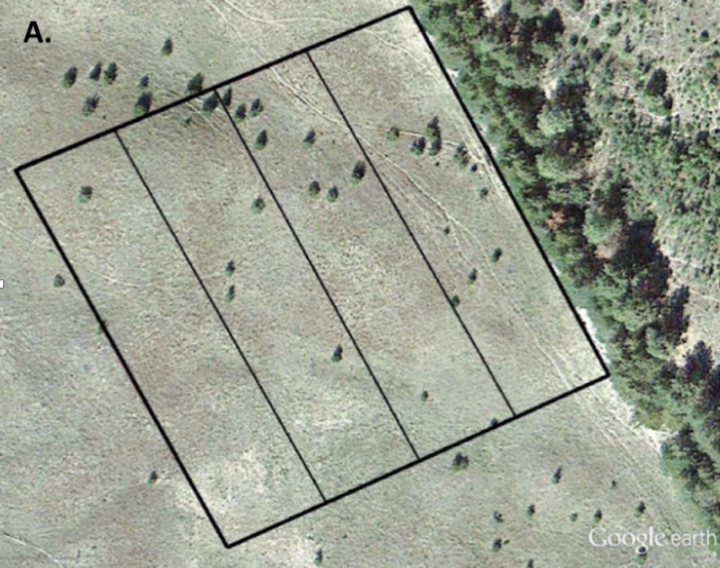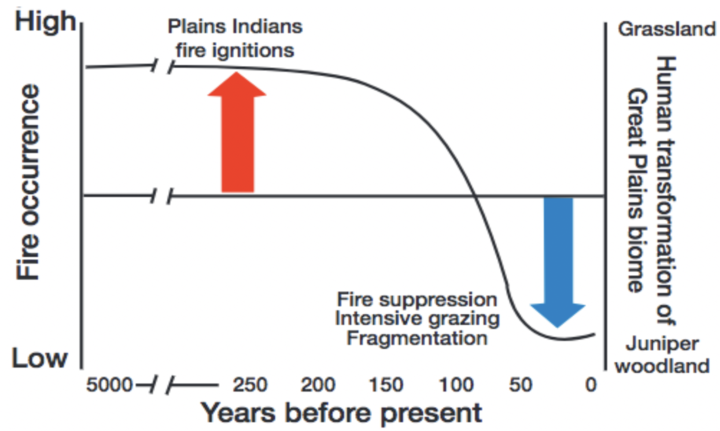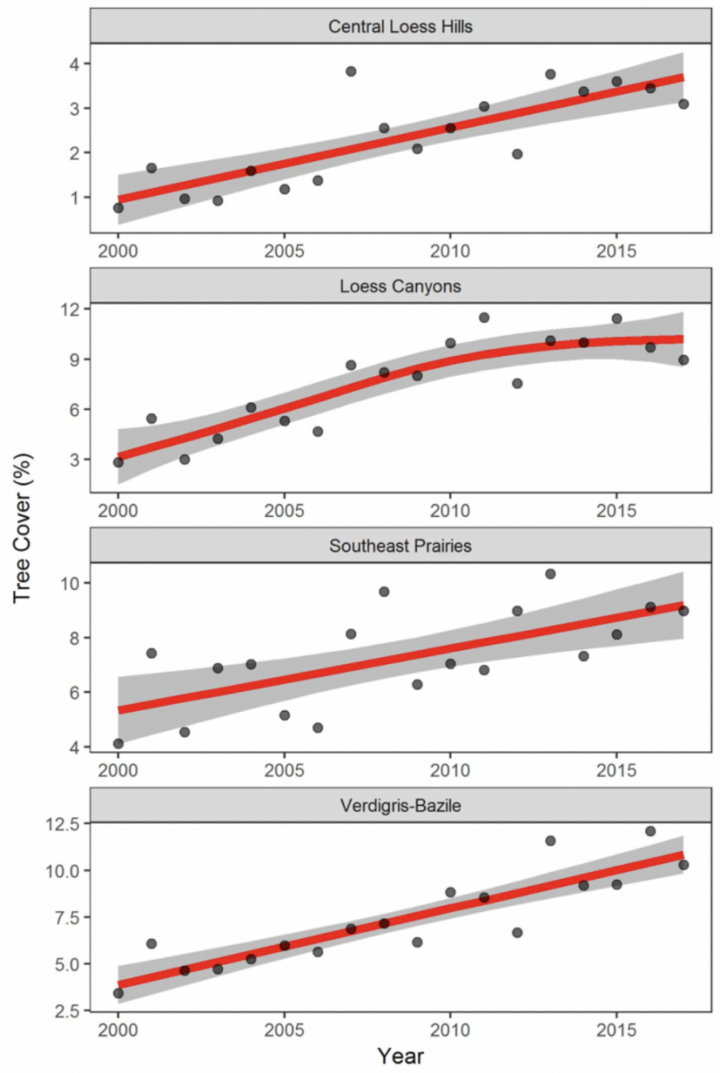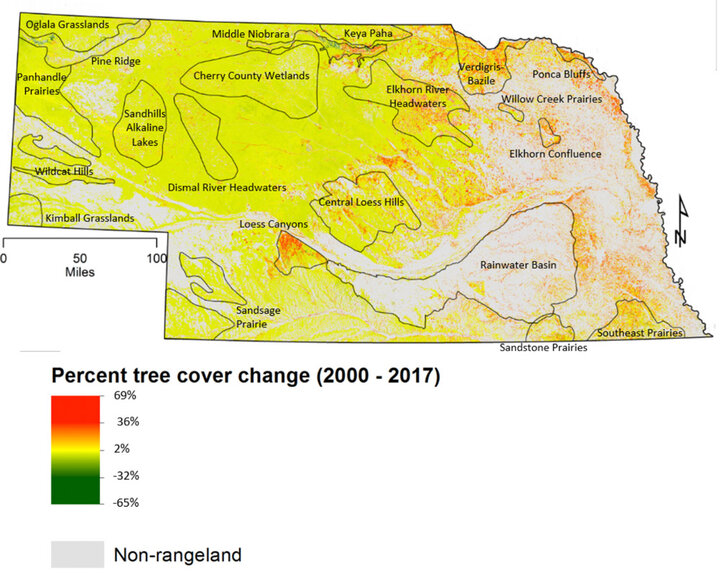The most published scientific experts on eastern redcedar invasion give answers to some of the most frequently asked questions on the impact, invasion, and control of Eastern redcedar.

Figure 1. Percent change in tree cover in Nebraska’s rangelands since 2000. Observed changes are driven primarily by the invasion of eastern redcedar (Fogarty dissertation research).
Why was eastern redcedar rare historically?
Eastern redcedar was historically rare in Nebraska, occurring only where fire could not occur (Miller 1902; Kellogg 1905; Harper 1912; Arend 1950, Blewett 1986; Briggs et al. 2002). This non-resprouting tree is one of the most fire-sensitive plants in the Great Plains (Twidwell et al. 2013b). Consequently, eastern redcedar was kept in low abundances by frequent human-ignited prairie fires and wildfires and thrived primarily in places where individual trees could escape fire damage (Briggs et al. 2002; Twidwell et al. 2013b).
The removal of this historical controlling process, coupled with ubiquitous planting and distribution of eastern redcedar, set the stage for widespread invasion and proliferation in grassland-dominated states (e.g. Nebraska; Fig. 1).
What practices contribute to the spread of easter redcedar?
Today, Great Plains grasslands are experiencing widespread invasion of eastern redcedar as a result of the following practices:
- Human dispersal of tree plantings into new environments. Eastern redcedar in windbreaks and man-made forest stands distributes seed sources into new habitats and facilitates its invasion into rangelands. Research now conclusively shows eastern redcedar trees spread from windbreaks in the Nebraska Sandhills (Donovan et al., 2018; Fig. 2), which some scholars previously assumed to be a region that would not be invadable by eastern redcedar.

Figure 2. Eastern redcedar spread from a windbreak in the Nebraska Sandhills (figure from Donovan et al., 2018).
- Removal of fires conducted by indigenous groups. The Great Plains was one of the most frequently burned biomes in the world since the last ice age. Humans were the main source of fire in the Great Plains for thousands of years to achieve multiple management objectives such as attracting bison and other ungulates for hunting, driving animal herds, clearing land for safer nomadic travel, encouraging early-successional fruits and nuts, farming, and for reducing pest populations (Axelrod, 1985). The tallgrass prairie of the Great Plains ranged from central Canada to the Texas-Mexico border and one-third of it is estimated to have burned every year. Changes in human fire-ignitions in the Great Plains following European settlement removed the top-down control that kept eastern redcedar rare historically (Fig. 3; Twidwell et al. 2013).

Figure 3. Human-induced fire ignitions shaped the Great Plains biome into one dominated by grassland with scarce eastern redcedar populations. The removal of Plains Indians fire ignitions and widespread fire suppression has resulted in widespread eastern redcedar invasion (figure from Twidwell et al. 2013b).
- Elimination of extreme fire events. Eastern redcedar is one of the most fire-sensitive plants in the Great Plains. The fireline intensity required for mortality of an individual juniper tree is 160 kJ m-1 s-1 and varies slightly depending on the height of the tree (Twidwell et al. 2013c). Historically, the rare occurrence of extreme fire events pushed juniper-dominant vegetation toward grassland dominance (Twidwell et al. 2013b; Bielski Dissertation research). Today, fire management policies impose caps on the range of fire intensities that are possible in prescribed burning, and models derived from fire physics show policy limits prescribed fires in rangeland to the bottom 25% of potential fire intensities (Twidwell et al. 2016). Cedar trees are therefore able to escape fire damage more often today than occurred previously (Twidwell et al. 2013c). This is referred to as a threshold imposed by modern policy in the disciplines of conservation biology and restoration ecology (e.g. Lindenmayer and Luck 2005).
What is the potential economic loss caused by the spread of eastern redcedar (with emphasis on Nebraska)?
The scientific impacts of eastern redcedar invasion have been recently investigated for two sectors of Nebraska’s economy. The full economic impacts of eastern redcedar invasion correspond to a diverse suite of potential social and environmental sectors and has yet to be explored in scientific research.
- Nebraska is at the early stages of eastern redcedar invasion in Nebraska, but has lost nearly half a million acres of grazing land since 2000 with an estimated economic impact of $18.7 million. Economic losses in grazing lands have consistently been shown to correspond to a 75% reduction to livestock stocking rates on rangelands that transition to eastern redcedar woodland (Fuhlendorf et al. 2008). Based on cash rental rates in Nebraska’s districts (Jansen et al. 2018) and ongoing research on the potential distribution of eastern redcedar woodland in Nebraska (Fogarty dissertation research), a first approximation of the economic risk to Nebraska’s grazable lands is $360 million per year (Twidwell et al. to be submitted for scientific peer-review). These results should be considered preliminary findings.
- Nebraska public schools have lost over $2.4 million in potential revenue from 2006-2016 to increase cedar management control efforts (Lally et al. 2016). As cedars continue to expand in Nebraska, the School Land Trust has initiated a campaign to protect grazing revenue and halt cedar invasions onto Trust lands. The Trust first established programs to control cedar in the 1980s. That campaign has been stepped up in the last ten years. The School Land Trust has increased annual expenditures for cedar control by $250,000 since 2006. The scientific consensus is that such control measures are necessary to prevent economic collapses in grazing revenue long-term. Losses in profitability are impacted by decisions made on neighboring lands; increasing investments become required for management to stay ahead of the increased seed sources in the surrounding landscape.
- Additional economic costs expected to vary across Nebraska. Decreases in water yield, wildfire regulation, and an increase in the number of threatened and endangered species will result in economic losses. However, interactions between eastern redcedar invasion will be different across regions and no economic research has been conducted in this area.

Figure 4. New rangeland inventory shows the relative performance of eastern redcedar conservation expenditures in four Nebraska BULS that have received significant cost-share investments.
Is there any evidence for sustainable rangeland management in regions following the onset of exponential growth of cedar?
- Only one group in the Great Plains has demonstrated the capacity to stabilize a region following the onset of exponential growth of eastern redcedar (Fig. 4; Fogarty dissertation research).
This is the result of unique partnership in the Loess Canyons BUL where landowners, scientists, and agencies (Nebraska Game and Parks Commission, Pheasants Forever, Natural Resource Conservation Service) have leveraged resources in new ways to scale-up eastern redcedar control, and this region provides the first scientific evidence for sustainable rangeland management in areas with higher amounts of juniper cover in the Great Plains. Other regions in Nebraska that have received significant conservation investments for eastern redcedar control continue to increase (Fig. 4).
How will cedar invasion influence other grassland habitat management strategies?
- Eastern redcedar invasion limits the influence of other habitat management strategies for grassland wildlife. Eastern redcedar invasion eliminates habitat for grassland-dependent wildlife and will limit the efficacy of numerous grassland-based conservation programs. Habitat management strategies such as conservation grazing, establishment of food plots, and wildflower planting will have limited, if any, impact on grassland wildlife abundance if eastern redcedar invasion is not controlled.

Figure 5. Percent tree cover change from 2000 - 2017 in Nebraska’s rangeland Biologically Unique Landscapes (Fogarty dissertation research).
How will critical grassland habitat be affected (with emphasis on Nebraska)?
- Eastern redcedar is increasing in Nebraska’s Biologically Unique Landscapes (BULs). Eastern redcedar is invading Nebraska’s BULs, threatening common and at-risk grassland wildlife (Fig 5; Fogarty dissertation research). For most rangeland BULs, eastern redcedar invasion has reached stages that are expensive to manage mechanically, and invasion continues to outpace control. Preventing the establishment ofeastern redcedar, and managing invasion during the early stages (i.e., when trees are not detectable with satellite imagery) is a recommended strategy for managing tree invasions across the world’s grassland regions (Beale et al. 2013).
